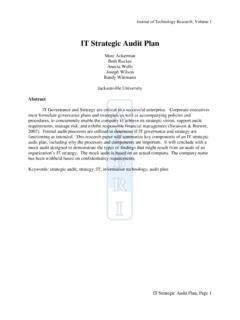Transcription of Internal Audit’s role during the strategic …
1 Internal audit s role during the strategic transactions life cycleInsights on governance, risk and complianceApril 2013iiiInsights on governance, risk and compliance | April 2013 Background ..1 Why IA should play a role during strategic transactions ..3 Role of IA during M&A ..6 Role of IA during divestitures ..10 Conclusion ..13 Contents ivInsights on governance, risk and compliance | April 2013 Throughout the strategic transaction process, Internal audit (IA) should act as a business advisor to the organization. IA can assess and monitor program management activities, review controls and provide key insights, while maintaining independence and on governance, risk and compliance | April 2013 strategic transactions such as mergers and acquisitions (M&A) and divestitures remain some of the most risk-heavy initiatives that any organization can to Ernst & Young s Capital Confidence Barometer (April October 2012), a survey of senior executives from large organizations around the world, global confidence in the economic recovery is markedly more optimistic.
2 More than 50% of executives now think that the global economy is improving. In fact, companies are looking to grow 52% cite growth as a primary focus, the highest response since the survey began in April 2010. This optimism is feeding an increased appetite for acquisitions. Emerging market investment appears particularly enticing for the following sectors: financial services, life sciences (including health care), consumer products, oil and gas, and are also seeing the appetite for divestitures growing. In the Ernst and Young 2012 Global Corporate Divestment Study, respondents noted that: Seventy-seven percent intend to accelerate divestment plans over two years. Fifty-eight percent would ramp up divestments but are concerned about the weak economy. Forty percent said buyer competition helped drive up divestment values are seeing an increase in M&A and divestitures: some geographies are still suffering from the crisis; and therefore, the divestitures continue.
3 In other geographies the expectations are already more positive, with an uptake in M&As as a result. However, the conditions for completing the transactions remain challenging. Our study noted that increased stakeholder scrutiny and preparation are challenging buyers and sellers in terms of scope and areas of of closing M&A deals is expected to be greater than it was six months on governance, risk and compliance | April 20136 12monthsIn progress/planning15%14%17%19%35%1 2 yearsNot planningbut am opento opportunitiesNone in theforeseeablefutureDozens of studies in the past few years have identified strategic transactions that did not give desired results to the stakeholders and discovered a need to do something different. A large percentage of buyers have actually destroyed shareholder wealth, and few have produced significant years, many organizations have suffered poor strategic transactions results because they did not have appropriate deal processes in place.
4 However, organizations have since made a number of improvements to improve deal value. Most companies no longer wait for the close to prepare to integrate or spin off. Integration or spin-off planning often starts as part of due diligence and negotiations. Some companies have started using integration clean teams to facilitate early decision making affecting people, products, suppliers and customers. The strategic transaction factory concept integration or spin-off as a repeatable process has become quite well accepted, with permanent, full-time Internal staff dedicated to integration/spin-off procedures now being common for serial acquirers and/or greater involvement in integration by corporate , despite these improvements, strategic transactions remain one of the most risk-heavy initiatives that any organization can undertake. Given the high-risk profile of these key transactions , the proactive involvement of IA before, during and after the merger, acquisition or divestiture can help management identify issues and opportunities related to the transaction that might not otherwise be addressed.
5 In following pages, we highlight why IA should play a role during such strategic transactions and discuss the roles an IA department can play to support management and enhance the value to the percent are in the process of divesting or planning to divest in the next one to two do you expect to initiate your next divestment?3 Insights on governance, risk and compliance | April 2013 Why IA should play a role during strategic transactionsFinancial statements are only as good as the risk and control environment that support them. IA can play a role in divestitures by ensuring that controls remain strong during the financial statement carve out, and operational and IT transition. Similarly, without IA s involvement, the acquiring organization will not know whether the control environment has sufficient rigor, or if the state of risks and controls were taken into account at the time of valuation of the acquiring organizations. Organizations often underestimate the challenges associated with the acquisition or divestiture of a company or line of business.
6 Without IA s insight, costs could range from a loss of opportunity to additional investments required to fix the issues that were missed. Emerging market growth, valuation, the complexity of the control environment, increasing regulatory pressures these are all urgent issues where IA can provide critical input and strategic value early in the strategic transactions life Ernst & Young Future of Internal audit study, which included chief audit executives (CAEs), C-suite executives and board members, noted that 37% of IA departments are doing more than just integrating their own function during M&As. The study also shows that CAEs are taking leadership roles in the strategic transactions , and IA teams are often involved in the project management of the IA s involvement, the acquiring organization may not know whether the control environment has sufficient rigor or whether the acquisition or divestment is properly Ernst & Young The future of Internal audit is now.
7 Increasing relevance by turning risk into results4 Insights on governance, risk and compliance | April 2013 How IA can help during strategic transactions Provide increased visibility and transparency to key risks related to strategic transaction changes ( , highlight potential finance, IT, HR or operational risks) Reinforce ownership that risks and controls are the responsibility of management Identify gaps in the integration or separation project management plan Suggest opportunities for additional synergies that would boost the acquisition s return on investment (ROI) or cost savings as a result of the separation Call out the impact that the acquisition and its integration, or the divestiture, may be having on other parts of the business Highlight potential gaps in the Internal control structure Support management s prioritization of risks of transition and organizational readiness for the effective and efficient allocation of resources to address the risks and controls Provide increased visibility of process changes impacting management s 302 certification on governance, risk and compliance | April 20136 Insights on governance, risk and compliance | April 2013 Role of IA during M&A There are four key areas where IA can play a crucial role in an organization s M&A life Strategy2.
8 Due diligence3. Deal approval and close4. IntegrationIA M&A program management processM&A life cycleIA should review the deal approval process to make sure that short- and long-term goals are defined before the deal the M&A process, IA should form a part of the program management team so that it can assess and monitor program management activities and provide key insights. IA can also audit program management activities to highlight process gaps and areas of future on governance, risk and compliance | April 2013 Role of IA during M&AProcessValueIA objectiveAssess valuation process Validation of valuation process including deal synergies Early insights on Internal control environment and overall compatibilityConduct Internal controlsand risk diligence Assess synergy validation processPurchase price support: Valuation with and without synergy considerations Revenue and profitability projectionsFinancial statement analysisTax implicationsProvide early insights on risk coverage and management: strategic governance, reputation Financial IT systems, credit/economic risks, tax Operational IT systems, customer, supply chain Regulatory compliance (SOX readiness, FCPA, OSHA, EPA, etc.)
9 Assess synergy assumptions and variables and compare them with past experiences from similar transactions and benchmarkingAssess or assist with validating deal synergies and feasibility of fully realizing stated synergy goals Provide early insights on opportunities to increase or accelerate transaction value and ROID uring the due diligence process, IA can assess the valuation process, the risks and Internal control environment and the synergy validation process. These assessments will enable the organization to determine whether the price is right, and provide early insights on any risk or control issues that may be lurking beneath the financial statements; also, what kind of synergies the acquisition target offers to improve the buyer s return on corporatestrategy process Validation of alignment with corporate vision Enhancement of risk identification and mitigation Validation of business case Assess the risksto the organizationAssess businesscase processProcessValueIA objectiveAlignment with corporate vision for growthEvaluate process for targetingacquisitionsManagement effort on value-creating initiatives: Identification and prioritizationof potential risks related totargeted merger/acquisition.
10 People Customers Business operations Finance and IT infrastructureEvaluate and/or assist mitigation actionsCosts identified and projectionsclearly statedSynergies identified and projectionsclearly stated (value and timing)Consideration of dis-synergiesunavailable ( , benefit plans,facilities)Assumptions for exit costsaccurately applied in the business caseROI projections and monitoring process Near- and medium-term goals for which the M&A team can beheld accountableM&A strategy formal documentationAn organization may have a target in its sights, but before it makes a move, IA should review the corporate strategy process, assess the risks to the organization and evaluate the business case process. This will ensure that the organization can determine from the beginning whether the acquisition target aligns with the organization s corporate growth strategy ( , whether it is the right fit).1. Strategy2. Due diligence8 Insights on governance, risk and compliance | April 2013 Before the organization signs the agreement, IA can review the deal approval process to make sure that short- and long-term goals are defined before the deal closes.















